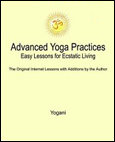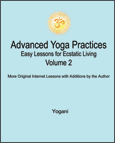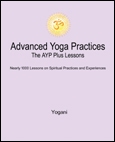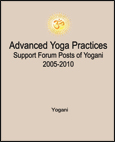|
Public Home | Plus Home | Main Lessons | Tantra Lessons | Public Forum | Plus Forum | Downloads | Books Topic Paths | Search | Training-Retreats | Testimonials | Survey | Interviews | MultiMedia | Contact | Donate |
|
Advanced Yoga Practices Note: For the Original Internet Lessons with additions, see the AYP Easy Lessons Books. For the Expanded and Interactive Internet Lessons, AYP Online Books, Audiobooks and more, see AYP Plus. Lesson 428 - The Transformation of Ego (Audio)
AYP Plus Additions:
From: Yogani New Visitors: It is recommended you read from the beginning of the archive, as previous lessons are prerequisite to this one. The first lesson is, "Why This Discussion?"
A: There can be no "getting rid" of the ego, because ego is a product of the mind, and so too is the act of getting rid of something an act of the mind. We can move things around in the mind, but we cannot get rid of them, except by transcending the mind altogether. This is what meditation is for cultivating abiding inner silence, that which is beyond the mind. But in doing so, we are not getting rid of the mind or the ego, we are only illuminating them with our inner light of pure bliss consciousness. In this way both the mind and the ego are transformed in their role in the expression of our life, which radiates more and more from the infinite source of peace and creativity within us. After a few years of practice, you are finding inner silence and the divine flow emerging in your everyday life, and it is natural to want to get on with it, so it can become a full time experience. It is your bhakti that is driving you forward. Inner silence tends to amplify our bhakti, and it also moves us toward self-inquiry. It is normal. When our thoughts and feelings, including the ego, or "I thought," are becoming objects of perception on the screen of our abiding inner silence (witness), we are naturally inclined to do something with them, particularly when they are influencing our perceptions and actions in life in negative ways, like those acts that are driven by the "I, me, mine" reflex. We'd like to get rid of that for sure. But doing so is not a doing. It is an undoing, and that is the trick. If you are being drawn to self-inquiry, then it is time. But, like with all practices, self-pacing will be necessary. Self-inquiry can be very helpful once we are able to release our inquiry in stillness (samyama effect), no matter what procedure of inquiry we may be using. That requires some abiding inner silence, obviously. We will know our self-inquiry is gaining traction in stillness (relational) if we feel the identification of our awareness with objects fading when we engage in inquiry. If we are feeling strain, frustration, confusion, headache, etc., then we can be pretty sure we are getting ahead of ourselves in mind outside inner silence (non-relational), and it is time to self-pace. Lesson 356 provides additional perspective on relational versus non-relational self-inquiry, and technique suggestions as well. We will know self-inquiry is working when we find our sense of self gradually expanding beyond the limits of I, me and mine. This is not an elimination of the ego, per se, but an expansive transformation of it, not an expansion of I, me and mine, but an expansion of pure bliss consciousness radiating out through the personality. What is the ego anyway, but identified awareness? It is the same awareness that we find in enlightenment when identification has faded. Same awareness much happier situation. We have sometimes used the example of the nervous system being like a window that needs cleaning. On the inside is pure bliss consciousness and on the outside is the distorted view of that purity seen through the dirty window. With the methods of yoga, we are cleaning the window, so what is seen through it becomes steadily more clear and pure. In this example, the "ego" is the view of pure bliss consciousness seen through the dirty window. As we clean the window, the view becomes more clear, and perception and conduct become illuminated. There may still be some distortion, but in time even that will go. Our sitting practices will take care of it, and our entry into self-inquiry will clarify remaining misperceptions. We come to find that we never were the distorted view coming through the window, only identified with it. Is that getting rid of the ego, or a transformation of it? Because it will be a gradual process for most, viewing it as a transformation may be more practical. Also, seeing it as a transformation is less judgmental. If we see the process as a gradual transformation, we can accept the so-called ego at whatever stage it may be, without feeling like we have to shove it out the door, which will only strengthen it in the realm of the mind. Making an enemy of the ego is as fruitless as making an enemy of the mind (see Lesson 354). Instead, we gradually illuminate the ego from within by cleaning the window, and one day we realize that it has been pure bliss consciousness expressing in that impure form all the while. That "realizing" stage is where self-inquiry has its greatest value. Not much before. Abiding inner silence and the process of inner purification and opening lead to this condition where self-inquiry becomes highly relational (in stillness). We have called this stage "ripeness," the point where we are only a few steps away from falling off the tree into unending peace and happiness, no matter what may be going on in our surroundings. There can be regressions at any stage, but once the nervous system (our window) reaches a certain level of purity, there is little chance of losing it. By then, the natural momentum of outpouring divine love and stillness in action are working 24 hours per day, 7 days per week. Let us not forget that the ego is our primary vehicle to enlightenment. Who else besides the ego would be sawing the limb of ignorance, while sitting on the part that will fall? For those who might worry about this, the fall is into infinite peace and happiness. In spite of the "I, me and mine" impulse, the ego is always looking to expand its power and its view. Once it becomes clear that all power and knowledge are found by going within, the ego will lead us there. Nothing else can do it. If ego were not the one cutting the limb of ignorance off while sitting on it, there would be no limb, because limitation is what the limb is. We must operate from limitation to move beyond limitation. That is the rationale for spiritual practices, and it works. Odd as it may seem, the ego is our vehicle to enlightenment. We have to operate from where we are. It is not possible to operate from where we are not. Someone wrote me recently asking if it was okay to meditate to be more successful in business. I said, sure, go for it. Meditating for business will be sure to lead to a broader view. If that person were discouraged from meditating for business, how would he ever get beyond that need? Meditating and engaging fully in life is the fastest way to do it, not by condemning or trying to ignore the attachment to business. It is the same thing for health. Millions take up yoga practices for health. Why not? It works, and it leads to much more than physical health. It is the ego that wants to meditate, and that is great. It will lead beyond whatever the imagined reason is even the concept of enlightenment. Hard as we may try, we cannot imagine our way beyond the fact of what it is. We can only purify the vehicle (this nervous system the window) and become a fuller expression of our essential nature, which is pure bliss consciousness. If the ego seems to be sabotaging us at times, it is only lingering habit, something that will fade over time as we continue with daily practices, like so many of our negative behaviors have. Honestly, I can think of nothing that would want to meditate besides ego (identified awareness). If that were not the case, there would be only pure awareness, and meditation would not be about purification and opening, but about basking in the infinite. Even then, it is the person (the shadow of our transformed ego) who sits down to meditate. Or is it stillness in action sitting to meditate? Does it even matter? We can only operate from where we are, and there is no practical reason to divide ourselves into good and bad, ego and non-ego. It's all one thing (one awareness) in the process of transformation from expressing with identification to expressing without identification. When we talk about human spiritual transformation, we are talking about illumination from the inside. That is illumination of the heart, the mind, and all our actions in the world. This transforms the role of these elements of our nature, including the aspect that connects us consciously with our expression of body/mind in time and space. And that is the ego, even if only a faint remnant of the duality it was before it became permeated with inner light. The result is abiding inner silence, ecstatic bliss, and outpouring divine love for the benefit of all on this earth plane, and beyond. The guru is in you. Discuss this Lesson in the AYP Plus Support Forum Note: For detailed discussion on the practical utilization of relational self-inquiry (in ripeness), see the Self-Inquiry book and the Liberation book. For detailed instructions on building and maintaining a balanced daily practice routine with self-pacing, see the Eight Limbs of Yoga book. Also see and AYP Plus. |
|
|
|
Join the Mail List:
AYP Retreats
eBooks - PDF, EPUB
FREE eBooks with
SAVE with Bundled
|

























